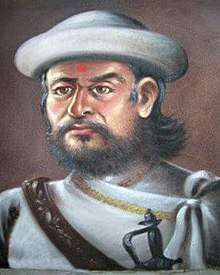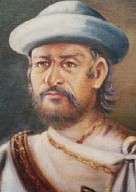Abhiman Singh Basnet
Abhiman Singh Basnet/Basnyat (Nepali: अभिमान सिंह बस्न्यात) was first Commander-in-Chief of Unified Nepal.[1] Abhiman Singh became the first Commander in Chief of a United Nepal after General Kalu Pande died during his second attempt to capture Kirtipur.
Abhiman Singh Basnyat | |
|---|---|
श्री मूलकाजी साहेब अभिमान सिंह बस्न्यात | |
 Portrait of Mulkaji Abhiman Singh Basnyat | |
| Mul (Chief) Kaji of Nepal | |
| In office 1772–1794 | |
| Succeeded by | Kirtiman Singh Basnyat |
| Personal details | |
| Born | 1744 AD (1801 B.S.) Gorkha, kingdom of Nepal |
| Died | 1800 AD (1857 B.S.) |
| Mother | Suraprabha Thapa Basnyat |
| Father | Shivaram Singh Basnyat |
| Relatives | Naahar Singh Basnyat (brother) Kehar Singh Basnyat (brother) Dhokal Singh Basnyat (brother) Kirtiman Singh Basnyat (nephew) Bakhtawar Singh Basnyat (nephew) |
| Military service | |
| Allegiance | |
| Rank | General |
| Battles/wars | Sino-Nepalese War |
He had participated in invasion of Makawanpur during Unification of Nepal.[2] He commanded battles in Sino-Nepalese War as subordinate commander under Chautariya Shree Krishna Shah.[3] He commanded and annexed Tanahun Kingdom into unified Nepal.[4]
In 1794 AD, King Rana Bahadur Shah dissolved government to overthrow Bahadur Shah of Nepal.[5][6] Kirtiman was appointed as Chief (Mul) Kaji among the four Kajis [6] succeeding Abhiman Singh.[7] In 1857 B.S., he was sent to settle the area of Morang and Sunsari, then called Kaala Banzaar. It was a great injustice to him to being sent to this area at such age when he was already a Mulkazi. Abhiman Singh died at the age of fifty-six in 1857. He was reported to have died from a fever, possibly malaria.
Early Life and Family
He was born on 1744 AD as third son of Basnyat nobleman Senapati Badabir Shivaram Singh Basnyat,[8] who died in the battle of Sanga Chowk during Unification of Nepal on 1803 B.S. (1747 AD).[9][10] He belonged to a Chhetri family.[11] His father was of Shreepali Basnyat pedigree[12] and his mother Surprabha was daughter of a Bagale Thapa nobleman.
Abhiman Singh had three brothers. His two elder brothers were Kazi Naahar Singh Basnyat and Kazi Kehar Singh Basnyat. His youngest brother, Kazi Dhokal Singh Basnyat, who became the governor of Kumaun, was the first owner of the present Narayanhity Palace.
Gallery
 Portrait of Abhiman Singh Basnyat
Portrait of Abhiman Singh Basnyat
References
- "Regmi Research Series" Author:Mahesh Chandra Regmi
- Hamal 1995, p. 185.
- "Archived copy". Archived from the original on 2016-12-20. Retrieved 2017-03-28.CS1 maint: archived copy as title (link)
- Hamal 1995, p. 186.
- Acharya 2012, p. 14.
- Pradhan 2012, p. 12.
- Karmacharya 2005, p. 56.
- Khatri 1999, p. 39.
- Shaha 1990, p. 27.
- Hamal 1995, p. 104.
- Mahesh Chandra Regmi 1975, p. 73.
- Hamal 1995, p. 182.
Sources
- Khatri, Shiva Ram (1999), Nepal Army Chiefs:Short Biographical Sketches, University of Michigan: Sira Khatri
- Regmi, D.R. (1975), Modern Nepal, 1, Firma K.L. Mukhopadhyay, ISBN 0883864916
- Shaha, Rishikesh (1990), Modern Nepal 1769–1885, Riverdale Company, ISBN 0-913215-64-3
- Hamal, Lakshman B. (1995), Military history of Nepal, Sharda Pustak Mandir, p. 125, OCLC 32779233
- Karmacharya, Ganga (2005), Queens in Nepalese Politics: an account of roles of Nepalese queens in state affairs, 1775-1846, Nepal: Educational Publishing House, ISBN 9789994633937
- Mahesh Chandra Regmi (1975), Regmi Research Series, 7, Regmi Research Centre